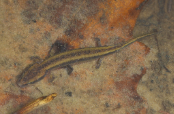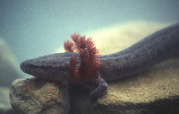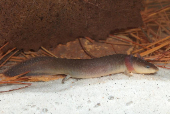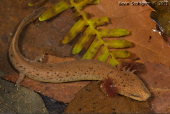Black Warrior Waterdog (Necturus alabamensis)
Description: The black warrior waterdog (Necturus alabamensis) is a large completely aquatic salamander that is gilled throughout life. It grows to a maximum recorded length of 9.8 inches and is medium sized when compared to other necturids. All members of this genus have bushy external gills, two gill slits, a laterally compressed tail, and four toes on front and hind feet. Adults vary in color with the dorsum being reddish brown to nearly black. It typically has enlarged dark spots that form a dorsolateral row or stripe contiguous with the dark stripe on the side of head. Tail has a dark band of pigment. Tips and underside of the toes and legs are light colored. The body and head are flattened. Sexually mature males can be distinguished by the swollen cloaca and pair of enlarged cloacal papillae that project posteriorly. Post hatchling juveniles have wide dark chocolate brown stripes on the dorsum and sides
separated by two distinct light-colored stripes beginning at the nostrils and ending at the tail.
Habitat: It is found in unsilted small and medium-sized streams in clay areas. It is more likely to be present when the larvae of the northern dusky salamander (Desmognathus fuscus) are present and less likely in streams where Asiatic mussels are abundant. The areas of dead leaves and detritus sometimes found in backwaters are important for this species.
Range: The Alabama waterdog is found in the Appalachian headwaters of the Black Warrior River drainage basin in Alabama. Its range includes the Sipsey Fork and Brushy Creek in Winston County, the Mulberry Fork, Blackwater Creek, and Lost Creek in Walker County, the North River and Yellow Creek in Tuscaloosa County, and the Locust Fork and Blackburn Fork in Blount County.
Found in these States:
AL
Diet: N. alabamensis typically consumes invertebrates such as crayfish, amphipods, and insect larvae, as well as vertebrates such as small fish.
Reproduction: Limited life history and ecology studies indicate this species is mostly nocturnal with nesting activity occurring in late spring or early summer.
Status: Listed as Endangered because its Area of Occupancy is probably less than 500km2, its distribution is severely fragmented, and there is continuing decline in the extent and quality of its forest habitat in Alabama.
»» Kingdom: Animalia - Animals
»» Phylum: Chordata - Chordates
»» Subphylum: Vertebrata - Vertebrates
»» Class: Amphibia - (Amphibians)
»» Order: Caudata - Salamanders
»» Family: Proteidae - Mudpuppies & Olm
»» Genus: Necturus
»» Species: Necturus alabamensis - Black Warrior Waterdog
This article uses material from the Wikipedia article "Alabama waterdog", which is released under the Creative Commons Attribution-Share-Alike License 3.0. Content may have been omitted from the original, but no content has been changed or extended.
|






